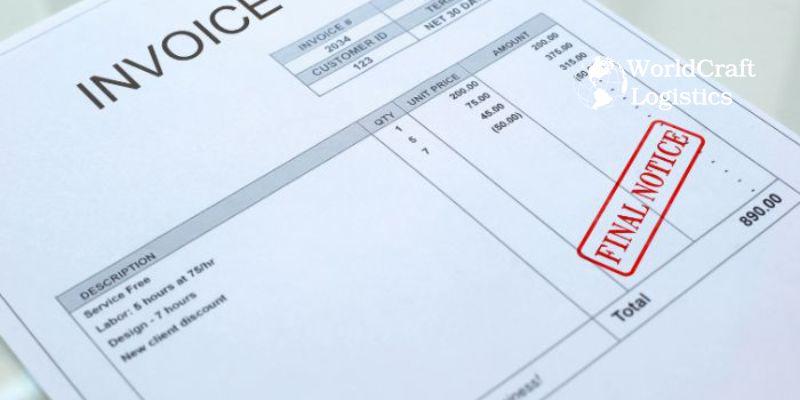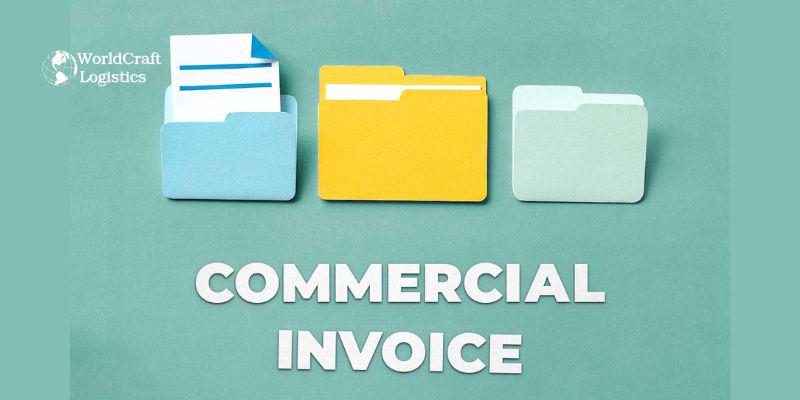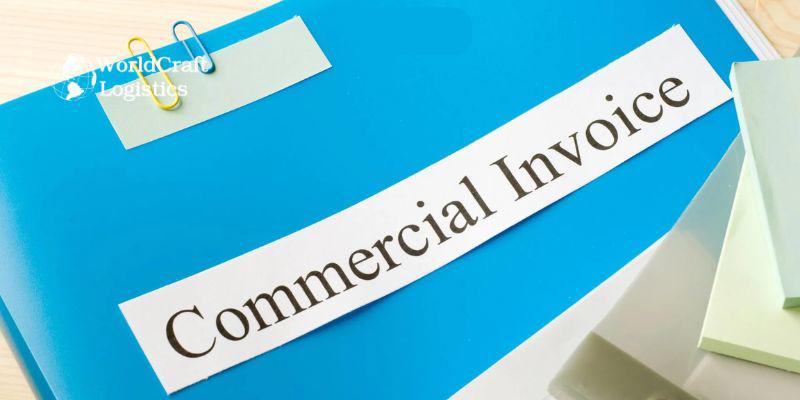
Starting June 1st, 2023 Our warehouse fee will be $0.65/cubic foot per month
In effort to lower the warehouse storage fee during inflation, we have went narrow aisle racking.This construction took us four months but the project is finally completed. With narrow aisle racking, we are able to drop storage by 24%.We as partners will go through this inflation together.
05/08/2024

Commercial invoices play an indispensable role in global shipping operations, with no room for oversight. Frequently, there's uncertainty surrounding the requisite documentation for ensuring seamless transit of your shipment to its ultimate endpoint. This piece elucidates the significance of a commercial invoice, its necessity, and provides guidance on completing it accurately.
This article addresses the following inquiries:
What is a commercial invoice and what is it used for?
What distinguishes a CN22 or CN23 form from a commercial invoice?
How should a commercial invoice be filled out?
Commercial invoice glossary
The commercial invoice must be added to the cargo in what way?

A vital document in international trade, the commercial invoice plays a crucial role in facilitating the passage of packages through customs. By ensuring the completion of a precise and accurate commercial invoice, exporters can assist customs authorities in swiftly determining the applicable taxes and import duties for the package, thereby averting potential delays.
Moreover, the commercial invoice enables customs officials to ascertain compliance with all regulatory requirements and relay pertinent information, such as the recipient's tax obligations, to the destination country. Accuracy in filling out this document enhances the likelihood of timely delivery. Notably, shipments within the European Union (EU) are exempt from this requirement, although exceptions exist for certain territories within the EU customs territory.
In addition to the commercial invoice, international shipments outside the EU may necessitate accompanying documents such as customs declarations (CN22 or CN23), a CP71 dispatch note, and potentially a Certificate of Origin (CO). This article will primarily focus on the significance of the commercial invoice in international shipping.
Articles with related topics:
👉 Customs Bonds: The value of US Import Bonds & Why important
👉 The Master Bill of Lading and the House Bill of Lading
👉 Shipping documents: Essential and ubiquitous documents in import and export
When dispatching a package overseas to a non-EU nation, multiple documents are typically required. The commercial invoice and the CN22 and CN23 forms are often sources of confusion among individuals. Despite both forms providing customs authorities with details regarding incoming and outgoing goods, they are distinct and should not be conflated. So, what sets them apart? Let's briefly explore the contents of each document.

A CN22 or CN23 form stands as a requisite customs document essential for shipments destined beyond the confines of the EU. Typically utilized for parcels handled by postal services, the choice between CN22 and CN23 hinges on the shipment's value or weight. Within these forms lie crucial details about the transported goods, pivotal in assessing tax obligations. Notably, a CN23 form always accompanies a CP71 dispatch note.
The commercial invoice is also an export document that you add to all commercial shipments outside the EU. It is a binding customs document that mainly contains information about the contents of the package and the agreements made (Incoterms), such as who pays the customs costs. Based on the commercial invoice, the customs authorities determine whether import duties have to be paid on the goods.
Completing a CN22 or CN23 form entails providing a more detailed set of information compared to a commercial invoice, though their fundamental purpose remains consistent. These documents serve to furnish customs authorities with pertinent details regarding package contents, aiding in the determination of the parcel's eligibility for entry into the respective country, as well as the allocation of tax and import duty responsibilities.
When dispatching a parcel to a non-EU destination via postal services such as PostNL (based in the Netherlands) or Royal Mail (operating in the UK), adherence to customs regulations is crucial. Utilize the CN22 or CN23 customs declaration form as mandated by the Universal Postal Union for international shipments. Additionally, inclusion of a commercial invoice is obligatory for such consignments to ensure smooth processing.
When opting for carriers like DHL or DPD over traditional postal services, there's no requirement to include a CN22 or CN23 form.
In e-commerce logistics, a critical distinction lies in the necessity of a commercial invoice, mandatory for all commercial shipments, as opposed to parcels dispatched through postal services which require the supplementary CN22 or CN23 document. For expedited processing, it is advised to consistently include both documents.

Commercial invoices must include specific elements, including details about the parties involved and information about the goods being shipped. The most challenging sections of the commercial invoice are outlined below, followed by an explanatory glossary.
Clearly detailing the package contents holds significant importance within the commercial invoice. Such delineation provides customs authorities with a comprehensive understanding of the shipped items. Each item must be described individually, elucidating its nature, composition, and purpose if applicable. Failure to accurately depict the contents could result in fines, as customs packages are routinely scrutinized. Thus, precision in description is paramount.
Furthermore, specifying the number of items, total weight, and total value in euros is crucial. Ensuring precise valuation is imperative, as even samples, gifts, or return shipments possess value.
Each item within your shipment requires an HS code or commodity code for proper classification. The Harmonized System (HS codes) categorizes goods to facilitate customs procedures, determining applicable taxes, excise duties, and controls. Accuracy in code submission is crucial as it dictates the extent of import duties and other levies. Although identifying the code may pose challenges, various methods exist for obtaining it.
Your product's manufacturer typically possesses knowledge of its HS code. Alternatively, you can conduct the search yourself. Access the customs administration website's trade tariffs section and navigate to the 'Nomenclature' tab for comprehensive commodity code listings. For further assistance, consult the manual on code retrieval. Additionally, reaching out to your country's tax and customs agency can provide additional guidance if needed.
In the "country of origin" section, you indicate the place where your goods were manufactured. Occasionally, a CO document may be required as supplementary paperwork. Certain non-EU nations may demand this documentation to comply with trade policy regulations.
The International Commercial Terms, commonly referred to as 'Incoterms', serve as standardized international agreements governing the transportation of goods. These terms elucidate key responsibilities:
💡 Allocation of shipping, insurance, import, and customs expenses associated with the shipment;
💡 Oversight of transportation logistics and destination;
💡 Assignment of accountability for the goods throughout the shipment process, including the moment when risks and expenses of delivery shift from the seller to the buyer.
It's important to note that the chosen carrier also adheres to these Incoterms.
Incoterms undergo updates every decade, with the latest revision in 2020. While the 2010 Incoterms remain valid, a growing number of businesses are transitioning to the 2020 version. For insights on the 2020 Incoterms, refer to our update. Among the commonly used Incoterms are EWX (Ex Works), FOB (Free on Board), CFR (Cost & Freight), DAP (Delivered At Place), and DDP (Delivered Duty Paid). If you're unsure which Incoterm suits your needs, we recommend opting for DAP. Under this term, the seller covers shipping expenses, arranges insurance, and prepares export documentation, while the recipient handles import and customs duties.
👉 Read this article now: What is HS Code? Meaning, how to find HS Code quickly & accurately

Commercial invoices are uniformly composed in English. Guidance for completing or creating one yourself, or using a template, is provided below:
📌 From: This is you, the person sending the package.
📌 To: The name and address of the person or company you are sending the package to.
📌 Intermediate Consignee: If you are sending the package to an intermediary, fill in the details of that person or company here.
📌 Date: The date you sent the package.
📌 Invoice Number: Your own invoice number.
📌 Customer PO No: Reference or order number of your sale.
📌 Currency Used: The currency you used when filling in the document.
📌 Country of Origin: The country where your product comes from. In some cases, you must add a CO document.
📌 Reason for export: Tick everything that is applicable.
📌 B/L/AWB No: This refers to the transport document setting out the arrangements with the carrier. The carrier is often responsible for preparing this document.
📌 Final Destination: The final destination of your package.
📌 Export Route/Carrier: The shipping company you are working with or the route your package will take.
📌 Terms of Sale: Better known as the Incoterms.
📌 Terms of Payment: The payment terms between you and the seller (e.g. payment within 30 days of receipt, direct deposit).
📌 Terms of Freight: Freight conditions (e.g. prepaid, collect). You can also enter these terms and conditions in the Terms of Sale or the Incoterms.
📌 No. of Packages: The number of packages you are sending.
📌 Comments: Space for shipping or delivery instructions or other notes.
📌 Contents: A description of the articles you are sending.
📌 HS Code: The HS code or commodity code.
📌 Value: Price per product.
📌 Net Quantity: Total number of products.
📌 Weight KG: Total weight of the package.
📌 Freight: If applicable, report the shipping costs here.
📌 Insurance: If applicable, report the insurance costs here.
📌 Date and signature: Your name, signature, and date. It may seem obvious, but your package will probably not be sent without your signature. So make sure to sign and date all your packages.
In standard export procedures, three copies of the commercial invoice are typically required: one for the origin country, one for the destination country, and one for the recipient. Two copies are to be placed in a packing list envelope affixed to the exterior of the package, while the third copy should be enclosed within the package for the recipient's reference.
Additionally, adherence to these packaging specifications is imperative:
Maintaining duplicates of the commercial invoice, as well as any CN22 or CN23 documents, is crucial. Errors in shipment handling can result in hefty customs charges. Therefore, it's prudent to remain prepared and retain documentation copies.
SEO
Digital Marketing/SEO Specialist
Simon Mang is an SEO and Digital Marketing expert at Wordcraft Logistics. With many years of experience in the field of digital marketing, he has shaped and built strategies to effectively promote Wordcraft Logistics' online presence. With a deep understanding of the logistics industry, I have shared more than 500 specialized articles on many different topics.

Education
01/05/2025

Education
02/18/2025

Education
01/01/2024

Education
08/28/2024

Education
11/13/2023